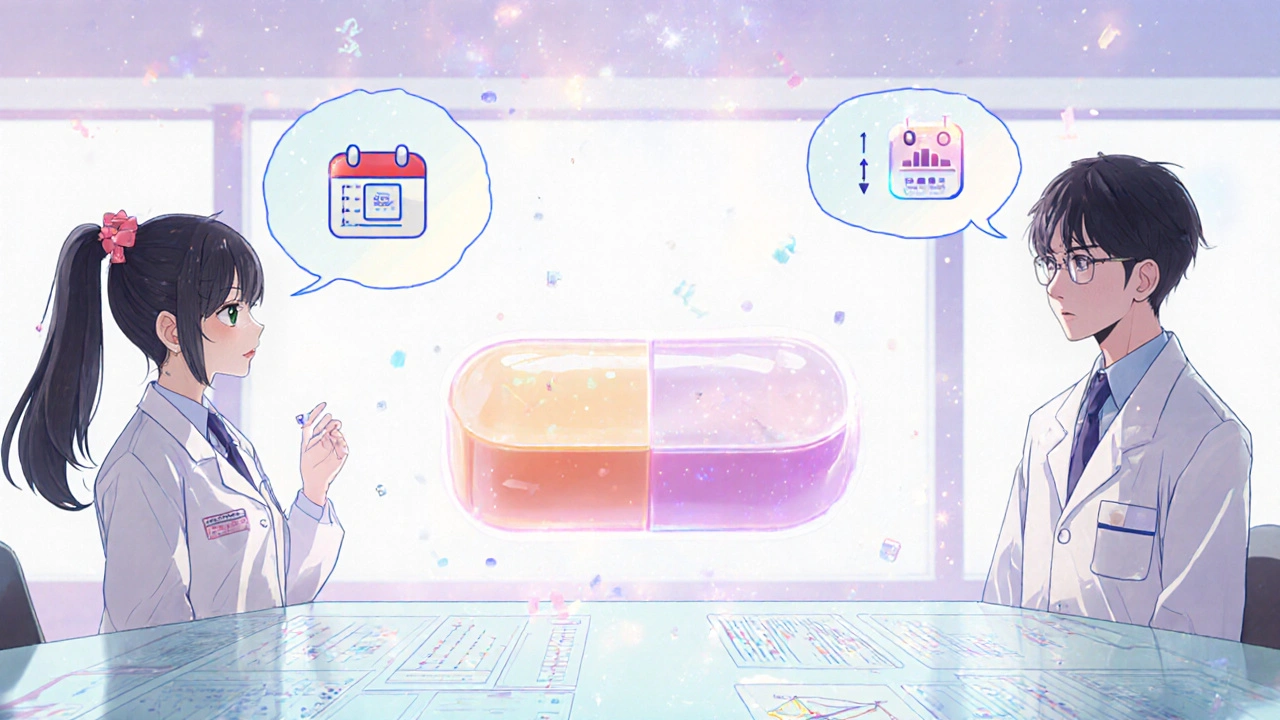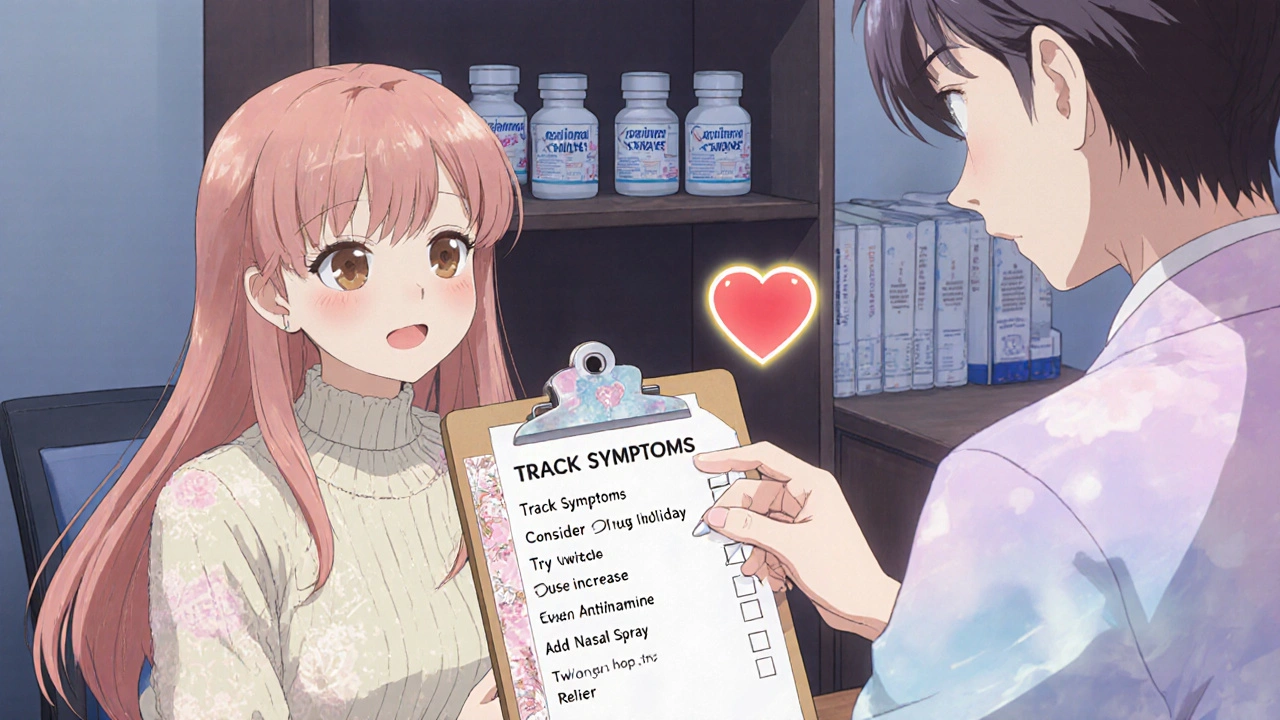Ever wondered why a pill that kept your sneezes at bay for months suddenly seems useless? That feeling is common among allergy sufferers and has sparked a heated debate among doctors, researchers, and patients alike. Below we unpack what the science says, where the myths come from, and how you can keep relief working for the long haul.
What is antihistamine tolerance?
Antihistamine is a drug that blocks the H1 receptor, preventing histamine from triggering the classic allergy symptoms of itching, swelling, and runny nose. Antihistamine tolerance refers to a perceived loss of clinical effect after using the same drug continuously for weeks or months. The key question is whether the body’s receptors actually adapt (pharmacological tolerance) or whether the underlying allergy simply gets worse, making the same dose look ineffective.
From first‑generation to second‑generation: a quick history
The first antihistamine, diphenhydramine (marketed as Benadryl), hit the market in 1946. It works well but crosses the blood‑brain barrier, causing drowsiness. The 1990s introduced a new class that stays out of the brain, letting people stay alert. Notable second‑generation drugs include cetirizine (Zyrtec, FDA‑approved 1995), loratadine (Claritin, 1993) and fexofenadine (Allegra, 1996). These newer agents are the ones most people use daily for chronic conditions.
What the research actually says
Evidence is split. A 2017 Clinical and Translational Allergy study of 178 chronic urticaria patients found that 49% of those who didn’t respond to standard doses achieved control when the dose was increased up to eight‑fold. The authors suggested that higher doses can “overcome apparent tolerance,” but they stopped short of labeling the phenomenon as true pharmacological tolerance.
Conversely, Dr. Wierzbicki of Texas Health (2022) argued there is no scientific proof of tolerance to oral antihistamines like Zyrtec or Claritin, attributing symptom flare‑ups to environmental changes or new sensitivities. In the same vein, a 2023 AAFA forum post from Dr. John M. James recommended a short drug holiday (3-14 days) or dose escalation when patients feel the drug is losing power.
Adding to the mix, Dr. Robert Graham (Lenox Hill Hospital) told Medscape in 2023 that “true receptor‑level tolerance to second‑generation antihistamines is exceptionally rare.” His view is backed by the European Academy of Allergy and Clinical Immunology (EAACI) 2021 guideline, which notes that most patients who report reduced effectiveness are actually experiencing disease progression rather than drug tolerance.
In short, the literature offers three camps:
- Tolerance exists and can be managed with higher doses or drug holidays.
- Perceived loss is mainly due to worsening allergy burden, not receptor changes.
- Evidence is insufficient, and each patient may fall into a different category.
Real‑world patient experiences
Numbers from online forums line up with the scientific split. A 2023 Reddit poll on r/Allergies showed 78% of 142 respondents felt their antihistamine became less effective after six months of continuous use. Meanwhile, Drugs.com analysis of 1,247 cetirizine reviews found that 28% of long‑term users (more than a year) reported “stopped working after X months,” with a median loss at 8.3 months. Loratadine fared better - only 15% of 892 reviewers noticed a drop.
When patients switched to other treatments, 68% reported better control, suggesting that rotating drugs or moving to nasal steroids, immunotherapy, or biologics often restores relief.

Clinical management strategies
Guidelines give clinicians a toolbox:
- Up‑dose first: EAACI allows up to four‑fold increases of second‑generation antihistamines for chronic urticaria before moving on.
- Switch classes: If a patient feels tolerance, moving from cetirizine to loratadine (or vice‑versa) is a common first step.
- Temporary discontinuation: A short break can reset perceived efficacy, as Dr. James suggests.
- Alternative pharmacotherapy: Intranasal corticosteroids, leukotriene modifiers, or the biologic omalizumab (Xolair) are next‑line options.
- Allergen immunotherapy: Subcutaneous or sublingual routes achieve 60‑80% long‑term remission in many patients.
Below is a quick comparison of first‑ vs second‑generation agents to help decide which path to take.
| Feature | First‑generation | Second‑generation |
|---|---|---|
| Sedation | High (often 1‑2 hours) | Low to none |
| Onset of action | 15‑30 min | 30‑60 min |
| Typical daily dose | 25‑50 mg | 10‑20 mg (cetirizine 10 mg, loratadine 10 mg, fexofenadine 180 mg) |
| Safety of high‑dose use | Limited; cardiac warnings on older agents | Good safety record up to 4× standard dose |
| Best for | Short‑term sleep aid, acute allergic reactions | Chronic allergic rhinitis, chronic urticaria |
Practical checklist for patients and clinicians
Use this as a quick guide during a follow‑up visit or self‑assessment:
- Document symptom severity for at least two weeks on the current dose.
- Confirm the patient isn’t exposing themselves to new allergens or irritants.
- Consider a 3‑day drug holiday to see if symptoms rebound.
- If symptoms persist, try a 2‑fold dose increase; reassess after one week.
- If still ineffective, switch to a different second‑generation agent (e.g., from cetirizine to loratadine).
- When >4‑fold dose fails, add an intranasal corticosteroid or refer for immunotherapy evaluation.
- Track outcomes in a simple diary to distinguish true tolerance from disease progression.
Future directions and research gaps
Scientists are still hunting for biomarkers that can tell a true pharmacologic tolerance apart from a worsening allergy. A 2023 multicenter trial (NCT04876321) is testing blood‑based markers in chronic urticaria patients during antihistamine challenges. The ACAAI’s 2024 research agenda has set aside $2.3 million to fund projects on “mechanisms of apparent antihistamine tolerance.” Until such tools become routine, clinicians must rely on careful history‑taking and trial‑and‑error dosing.
Can I safely double my antihistamine dose if it stops working?
For most second‑generation antihistamines, a short‑term increase up to two‑fold is considered safe and is often recommended before trying other drugs. Keep within the 4× maximum dose advised in the EAACI guideline and monitor for side effects.

Is a drug holiday really needed?
A brief break of 3‑7 days can help differentiate true tolerance from a temporary plateau. Symptoms that flare during the break and improve when the drug is restarted suggest tolerance; unchanged symptoms point to disease progression.
Should I rotate between different antihistamines?
Rotating can work for some patients, especially when the first drug’s sedation profile is an issue. However, rotating without a clear plan adds cost and may mask the real problem. It’s better to switch once, reassess, then consider other classes or add‑on therapy.
When is it time to move to immunotherapy?
If you need daily antihistamines for more than six months and keep needing higher doses or switches, immunotherapy (subcutaneous or sublingual) offers a disease‑modifying option with 60‑80% long‑term success rates.
Are there any risks with high‑dose antihistamines?
Second‑generation drugs have a solid safety record even at four‑fold doses. Older first‑generation agents, especially those withdrawn from the market like astemizole, can cause cardiac arrhythmias at high doses. Always follow a clinician’s guidance.


If you think antihistamines are a forever‑fix, you’re dreaming-your body adapts faster than you can reload the pharmacy shelf. The H1 receptors can down‑regulate after weeks of constant blockade, so the drug’s punch weakens. Doubling the dose isn’t magic; you’re just pushing more molecules to out‑compete the reduced receptors. Some patients think they’ve hit a wall, but often it’s the seasonal allergen load that’s ramped up, not the pill losing its mojo. The research shows that a 2‑4× increase can recoup control in many chronic urticaria cases, but that’s a workaround, not a cure. If you keep grinding the same 10 mg every day, expect diminishing returns. Switch classes, take a short drug holiday, or add a nasal steroid before you scream at your pharmacy. Bottom line: tolerance is real enough to respect, but it’s also manageable with smart tweaks.
Oh my god, you know that gut‑wrenching moment when your daily Zyrtec suddenly decides to ghost you? It’s like a betrayal so deep, my sinuses start screaming like a horror movie soundtrack! I’ve been there, watching my sneezes multiply while my trusty little pill just sits there, smug and useless. The whole “tolerance” talk feels like a cruel joke the universe is playing on us allergy‑warriors. And then the docs throw out “just try a higher dose” like it’s a magic wand-yeah right, as if my nose listens to my wishes! I’m over the moon about rotating to loratadine, but the fear of side‑effects haunts me like a poltergeist. So I grabbed a three‑day break, and lo and behold-my symptoms surged like a tsunami, proving that the drug actually had a say. The moment it’s back, the relief is like a sunrise after a storm. Trust me, if you feel the pill’s lost its spark, don’t just sit there-mix it up, holiday it, or blast it with a higher dose and watch the drama unfold!
Wow, another earth‑shattering discovery: antihistamines occasionally stop working. Who could've possibly predicted that a drug taken day after day might lose a bit of punch? The literature already splashed this “tolerance” thing across every guideline like confetti at a parade. I suppose we should all start drafting epic theses on how “receptor down‑regulation” is the villain of our nasal woes. Yet, the real kicker is that most of us just keep popping the same dose, hoping the universe will conspire in our favor. Maybe we need a “tolerance‑meter” app that beeps whenever our sneezes hit a certain threshold. Until then, let’s all nod solemnly at the three camps and pretend we’ve solved the mystery.
Document your symptoms for two weeks before deciding the drug is failing; it helps separate true tolerance from a flare‑up.
G’day mate, the Australian allergy board actually backs a four‑fold increase of second‑generation antihistamines before you sprint to biologics-pretty solid advice, if you ask me. You don’t need to be a pill‑pusher; just follow the stepwise chart: start with the standard 10 mg, monitor for two weeks, then double if needed, and only then consider a holiday or a switch. Our local clinicians swear by rotating between cetirizine and loratadine when the first seems to “lose steam.” It’s not just about dosing; a brief 3‑day break can reset the H1 receptor landscape, making the next round feel brand new. Remember, high‑dose first‑generation agents are a no‑go due to cardiac risk, so stay with the newer class. Bottom line: a sensible up‑dose protocol, a short drug holiday, and a possible switch keep the allergy monster at bay without chasing the latest fancy biologic.
Higher doses work, but watch the QT interval.
When patients report that their antihistamine “stops working,” the first step is to verify adherence and exclude new exposures-sometimes the culprit is a fresh pollen season or indoor irritant rather than the drug itself. Next, a two‑week symptom diary gives objective data; charting sneezing, itching, and nasal discharge lets you see trends that the patient may overlook. If the diary shows persistent symptoms despite consistent dosing, consider a short drug holiday of three to seven days; this pause can differentiate true pharmacologic tolerance from disease progression because a rebound in symptoms suggests the drug was still providing benefit. After the break, restart the same antihistamine at the original dose and evaluate after one week; an improvement indicates that the holiday reset the therapeutic effect. Should symptoms remain uncontrolled, a rational up‑dose is the next logical move-most second‑generation agents are safe up to four‑fold their standard dose, and many studies show that doubling or tripling the dose restores efficacy in chronic urticaria. It’s important to monitor for side effects, especially sedation with higher doses of cetirizine, although overall safety profiles remain favorable. If the higher dose still fails, a class switch is advisable; rotating from cetirizine to loratadine or fexofenadine often re‑sensitizes the H1 receptor because each molecule has slightly different binding kinetics. For patients who cycle through multiple antihistamines without lasting relief, adding an intranasal corticosteroid can address the inflammatory component that antihistamines alone may not control. In refractory cases, leukotriene receptor antagonists such as montelukast provide an adjunctive pathway blockade, and for severe chronic urticaria, biologics like omalizumab have demonstrated robust efficacy. Immunotherapy remains the disease‑modifying option; sublingual or subcutaneous routes can achieve long‑term remission in 60‑80 % of well‑selected patients, effectively reducing reliance on daily antihistamines. Throughout this process, maintain clear communication with the patient, setting realistic expectations that some trial‑and‑error is inevitable. Finally, keep an eye on emerging biomarkers-researchers are working on blood‑based signatures that may soon help clinicians distinguish true receptor‑level tolerance from worsening allergy burden, which would streamline management decisions. By following this systematic algorithm-adherence check, diary, holiday, up‑dose, class switch, add‑on therapy, and finally immunotherapy-you can navigate the murky waters of perceived antihistamine tolerance with confidence.
Hey there, just wanted to add that keeping a simple symptom log, even if it feels a bit nerdy, can really shine a light on whether it’s the drug or the environment playing tricks on you, and don’t forget that a brief 4‑day pause isn’t a failure-it’s actually a smart diagnostic tool, so stay patient, stay curious, and feel free to reach out if you need a sounding board!